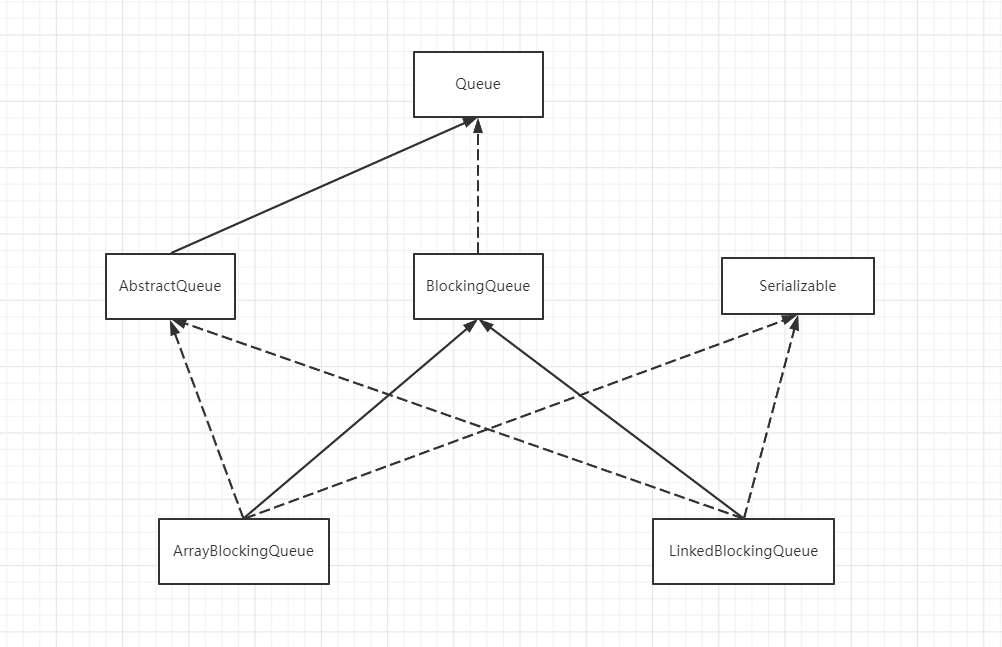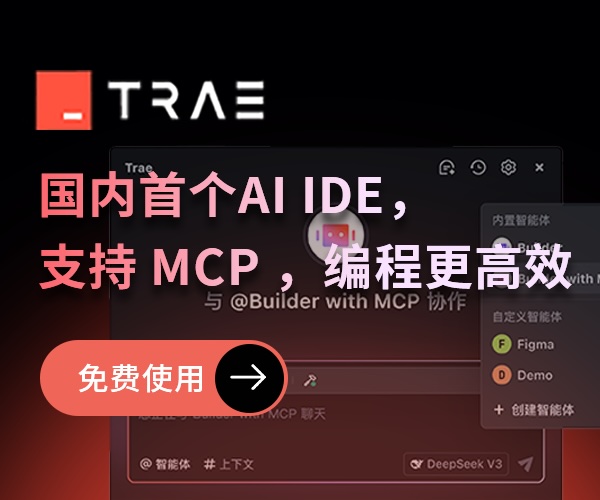BlockingQueue 源码分析
学习多线程定时器时遇到 BlockingQueue 阻塞队列,当时的认识仅限于了解其是一个并发阻塞队列,不知如何使用及其原理
1. 介绍
BlockingQueue 首先是一个队列,其次提供了阻塞功能。它看起来很像消息队列可让消息解耦,但其在生产者-消费者模型中通过阻塞又可使二者速度达到平衡。使用阻塞队列无需过多考虑线程安全问题,专注业务逻辑的实现即可
BlockingQueue 有正常的队列功能,即出队与入队。其阻塞体现在:
- 当队列满时,若有生产者继续往队列添加元素,则阻塞这个生产者线程
- 当队列为空,若有消费者继续从队列移除元素,则阻塞这个消费者线程
- 添加元素时,则队列不为空,则唤醒消费者线程
- 移除元素时,则队列不为满,则唤醒生产者线程
常见的阻塞队列:
- ArrayBlockingQueue:基于数组的有界阻塞队列
- LinkedBlockingQueue:基于链表的有界阻塞队列
- PriorityBlockingQueue:基于堆的优先级无界阻塞队列
- DelayQueue:基于时间优先级的无界阻塞队列
后面将介绍 ArrayBlockingQueue、LinkedBlockingQueue 两个阻塞队列, 其类继承图如下:

2. Queue 接口
Queue 接口具有队列的基本方法,其不同之处在于同一个功能他有两套方法,两套方法区别于一套是实现返回值,另一套是抛出异常
| Throw Exception | Return value | |
|---|---|---|
| 增加 | add() | offer() |
| 删除 | remove() | poll() |
| 检查 | element() | peek() |
3. BlockingQueue 接口
BlockingQueue 接口在 Queue 的接口上添加多几个方法或重载,最常用的方法有 put 和 take(有阻塞功能)
| 非阻塞 | 阻塞线程方法 | |
|---|---|---|
| 增加 | offer(E e, long timeout, TimeUnit unit):等待超时后返回值 | put() |
| 删除 | poll(long timeout, TimeUnit unit):等待超时后返回值 | take() |
| 包含 | contains(Object o) | |
| 剩余大小 | remainingCapacity() | |
| 转移元素 | drainTo(Collection<? super E> c) |
4. AbstractQueue 抽象类
通过 AbstractQueue 抽象类可知道 Queue 接口的两套方法其实本质是一样的,只不过多了一层抛异常的判断而已
public abstract class AbstractQueue<E> extends AbstractCollection<E> implements Queue<E> {
/**
* 构造器
*/
protected AbstractQueue() {
}
/**
* add 调用的还是 offer 方法返回值
*/
public boolean add(E e) {
if (offer(e))
return true;
else
throw new IllegalStateException("Queue full");
}
/**
* remove 调用的还是 poll 方法返回值
*/
public E remove() {
E x = poll();
if (x != null)
return x;
else
throw new NoSuchElementException();
}
/**
* remove 调用的还是 poll 方法返回值
*/
public E element() {
E x = peek();
if (x != null)
return x;
else
throw new NoSuchElementException();
}
/**
* 清空元素
*/
public void clear() {
while (poll() != null)
;
}
/**
* 批量添加元素
*/
public boolean addAll(Collection<? extends E> c) {
if (c == null)
throw new NullPointerException();
if (c == this)
throw new IllegalArgumentException();
boolean modified = false;
for (E e : c)
if (add(e))
modified = true;
return modified;
}
}
5. ArrayBlockingQueue
ArrayBlockingQueue 使用循环数组来存储元素,其大小是确定的,所以属于有界阻塞队列。阻塞功能由可重入锁实现,出队入队都靠同一个锁来控制,并且由条件锁来实现生产者和消费者线程的阻塞和唤醒。
5.1 内部属性
// 存储元素的数组
final Object[] items;
// 可获取元素的下标
int takeIndex;
// 可存放元素的下标
int putIndex;
// 元素总数量
int count;
// 可重入锁
final ReentrantLock lock;
// 非空条件锁,队列为空时阻塞消费者线程
private final Condition notEmpty;
// 非满条件锁,队列满时阻塞生产者线程
private final Condition notFull;
// 自定义的迭代器(可使用默认提供的)
transient Itrs itrs = null;
5.2 关键方法
// 入队,添加元素后队列则不为空,会唤醒被阻塞的消费者线程
private void enqueue(E x) {
final Object[] items = this.items;
items[putIndex] = x;
if (++putIndex == items.length)
putIndex = 0;
count++;
notEmpty.signal();
}
// 出队,移除元素后队列则不满,唤醒被阻塞的生产者线程
private E dequeue() {
final Object[] items = this.items;
@SuppressWarnings("unchecked")
E x = (E) items[takeIndex];
items[takeIndex] = null;
if (++takeIndex == items.length)
takeIndex = 0;
count--;
if (itrs != null)
itrs.elementDequeued();
notFull.signal();
return x;
}
5.3 常用方法
put、take 是最常用的方法,对应添加与移除元素
添加元素时,锁住整个数组。若队列满了则阻塞当前添加元素的线程,否则添加完元素后唤醒消费者线程进行消费
// 添加元素,
public void put(E e) throws InterruptedException {
checkNotNull(e);
final ReentrantLock lock = this.lock;
// 获取锁
lock.lockInterruptibly();
try {
// 若队满,则阻塞生产者线程
while (count == items.length)
notFull.await();
// 入队
enqueue(e);
} finally {
// 释放锁
lock.unlock();
}
}
移除元素时,锁住整个数组。若队列空了则阻塞当前移除元素的线程,否则移除完元素后唤醒生产者线程进行生产
// 移除元素
public E take() throws InterruptedException {
final ReentrantLock lock = this.lock;
// 获取锁
lock.lockInterruptibly();
try {
// 队空则阻塞消费者线程
while (count == 0)
notEmpty.await();
// 出队
return dequeue();
} finally {
// 释放锁
lock.unlock();
}
}
5.4 使用示例
下面来模拟一个生产-消费者场景。发现刚开始生产者一直生产商品,到队满后则被阻塞,此后消费者消费了一个商品后,生产者才生产一个商品
public class BlockingQueueTest {
public static void main(String[] args) {
ArrayBlockingQueue blockingQueue = new ArrayBlockingQueue(5);
// 生产者线程,每秒生产一个商品
new Thread(()->{
while (true) {
try {
Thread.sleep(1000);
System.out.println("生产者生产了商品");
blockingQueue.put(new Integer(1));
} catch (InterruptedException e) {
e.printStackTrace();
}
}
}).start();
// 消费者线程,每5秒消费一个商品
new Thread(()->{
while (true) {
try {
Thread.sleep(5000);
System.out.println("消费者消费了商品");
blockingQueue.take();
} catch (InterruptedException e) {
e.printStackTrace();
}
}
}).start();
}
}
6. LinkedBlockingQueue
LinkedBlockingQueue 底层是一个单向链表,可指定链表大小(不指定默认为 Integer.MAX_VALUE),实现原理和 ArrayBlockingQueue 类似,不同在于其链表的结构可实现同时出队和入队,此时需要两把锁来控制并发,所以其出队入队是不影响的
下面的实现类是 删除简化很多代码之后的结果 ,为了简洁的展示实现原理
public class LinkedBlockingQueue<E> extends AbstractQueue<E> implements BlockingQueue<E> {
/**
* 单向链表的节点
*/
static class Node<E> {
E item;
Node<E> next;
Node(E x) {
item = x;
}
}
/** 最大容量 */
private final int capacity;
/** 现有元素总数量,原子操作 */
private final AtomicInteger count = new AtomicInteger();
/**
* 链表头
*/
transient Node<E> head;
/**
* 链表尾
*/
private transient Node<E> last;
/** take方法的可重入锁,控制并发 */
private final ReentrantLock takeLock = new ReentrantLock();
/** take方法的条件锁 */
private final Condition notEmpty = takeLock.newCondition();
/** put方法的可重入锁,控制并发 */
private final ReentrantLock putLock = new ReentrantLock();
/** put方法的条件锁 */
private final Condition notFull = putLock.newCondition();
/**
* 唤醒非空阻塞的线程
*/
private void signalNotEmpty() {
final ReentrantLock takeLock = this.takeLock;
takeLock.lock();
try {
notEmpty.signal();
} finally {
takeLock.unlock();
}
}
/**
* 唤醒非满阻塞的线程
*/
private void signalNotFull() {
final ReentrantLock putLock = this.putLock;
putLock.lock();
try {
notFull.signal();
} finally {
putLock.unlock();
}
}
/**
* 链表尾入队
*/
private void enqueue(Node<E> node) {
last = last.next = node;
}
/**
* 链表头出队
*/
private E dequeue() {
Node<E> h = head;
Node<E> first = h.next;
h.next = h; // help GC
head = first;
E x = first.item;
first.item = null;
return x;
}
/**
* 入队
*/
public void put(E e) throws InterruptedException {
if (e == null) throw new NullPointerException();
int c = -1;
Node<E> node = new Node<E>(e);
final ReentrantLock putLock = this.putLock;
final AtomicInteger count = this.count;
// 获取 put 方法锁,锁住链表尾部
putLock.lockInterruptibly();
try {
// 队满时,阻塞添加元素的线程
while (count.get() == capacity) {
notFull.await();
}
// 入队操作
enqueue(node);
c = count.getAndIncrement();
// 添加元素后队列还没满,唤醒非满阻塞的线程
if (c + 1 < capacity)
notFull.signal();
} finally {
putLock.unlock();
}
// 说明队列为空了,唤醒被阻塞的生产者线程
if (c == 0)
signalNotEmpty();
}
/**
* 出队
*/
public E take() throws InterruptedException {
E x;
int c = -1;
final AtomicInteger count = this.count;
final ReentrantLock takeLock = this.takeLock;
// 获取 take 方法锁,锁住链表头部
takeLock.lockInterruptibly();
try {
// 队空时,阻塞获取元素的线程
while (count.get() == 0) {
notEmpty.await();
}
// 出队
x = dequeue();
c = count.getAndDecrement();
// 出队后,队列不为空,继续唤醒出队线程
if (c > 1)
notEmpty.signal();
} finally {
takeLock.unlock();
}
// 队满了,唤醒被阻塞的消费者线程
if (c == capacity)
signalNotFull();
return x;
}
}









